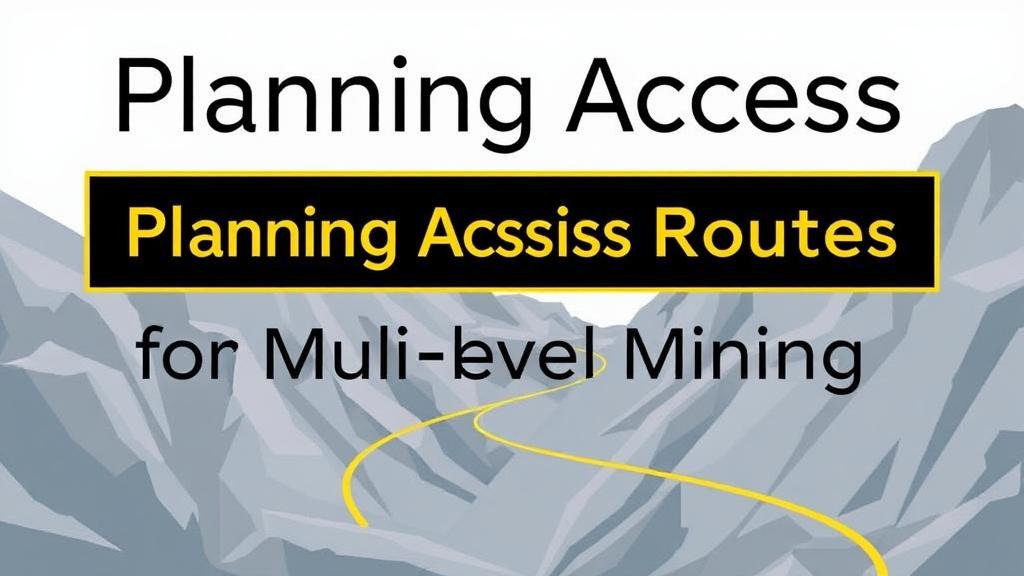Planning Access Routes for Multi-Level Mining Operations
Planning Access Routes for Multi-Level Mining Operations
Access routes in multi-level mining operations are critical for the efficient transportation of personnel, equipment, and materials. The planning and design of these routes can substantially influence operational safety, productivity, and cost-effectiveness. In this article, we will explore the key considerations for planning access routes in such complex environments, supported by relevant examples and statistics.
Understanding the Importance of Access Routes
Access routes serve multiple purposes in mining operations. facilitate:
- Transportation of workers to and from the site
- Movement of heavy machinery and materials
- Emergency response access during incidents
- Supply chain logistics for inputs and outputs
According to the Mining Industry Health and Safety Centre, poor planning of access routes can lead to significant delays and increased operational costs, with estimates suggesting up to 20% of downtime can be attributed to transport inefficiencies.
Key Factors in Route Planning
Several factors must be taken into account when planning access routes for multi-level mining operations. These include:
Topography and Geological Conditions
The natural landscape plays a fundamental role in route planning. Steep slopes, unstable soil, and geological formations can hinder construction and long-term sustainability. For example, a multi-level underground mine in Canada, the Highland Valley Copper Mine, faced challenges due to its hilly terrain, which necessitated the construction of switchback roads to ensure safe access and egress.
Safety Considerations
Mining operations are inherently dangerous, so safety must be the top priority when planning access routes. This involves:
- Useing robust guardrails and barriers
- Regular maintenance checks to ensure route integrity
- Signage and communication systems for hazard alerts
According to the World Health Organization, effective route planning can reduce accidents by as much as 40% in mining operations. This underscores the need for meticulous planning and the integration of safety standards.
Traffic Management
In multi-level mining operations, traffic management becomes increasingly complex due to the simultaneous movement of various traffic types. Effective traffic management strategies may include:
- Designating specific routes for light vehicles and heavy machinery
- Useing one-way traffic systems in high-density areas
- Scheduling transportation activities to minimize congestion
A case study at the Oyu Tolgoi mine in Mongolia demonstrates that careful traffic management not only increased efficiency but also reduced the risk of accidents significantly.
Technological Innovations in Route Planning
Modern technology has revolutionized the way access routes are planned in mining operations. Geographic Information Systems (GIS) and computer-aided design (CAD) software enable mining engineers to analyze topography, simulate traffic flows, and optimize route designs efficiently.
The use of drones and remote sensing technologies can also assist in the assessment of difficult terrains, thereby allowing for timely modifications to proposed routes based on real-time data. According to the International Council on Mining and Metals, these technologies can enhance route planning accuracy by up to 30%.
Environmental and Regulatory Compliance
Mining operations must adhere to environmental regulations that may dictate how access routes are constructed and maintained. Key compliance considerations include:
- Minimizing the ecological impact of route construction
- Maintaining compliance with local and national laws
- Incorporating erosion control and rehabilitation measures
For example, the Pasminco zinc lead mine in Australia successfully integrated environmental considerations into its planning processes, demonstrating that compliance can coexist with operational efficiency.
Conclusion and Actionable Takeaways
To wrap up, planning access routes for multi-level mining operations is a complex yet essential task that requires careful consideration of various factors, including topography, safety, traffic management, technology, and regulatory compliance. By embracing innovative technologies and highlighting safety protocols, mining companies can enhance operational efficiency while minimizing risks.
Companies should consider the following actionable steps when planning access routes:
- Conduct thorough assessments of geological and environmental conditions
- Use modern technological tools for route design and safety simulations
- Use robust traffic management systems tailored to operational needs
- Engage in continuous training and development programs for personnel
By integrating these approaches, mining operations can not only improve route efficiency but also promote a safer working environment for all stakeholders involved.



